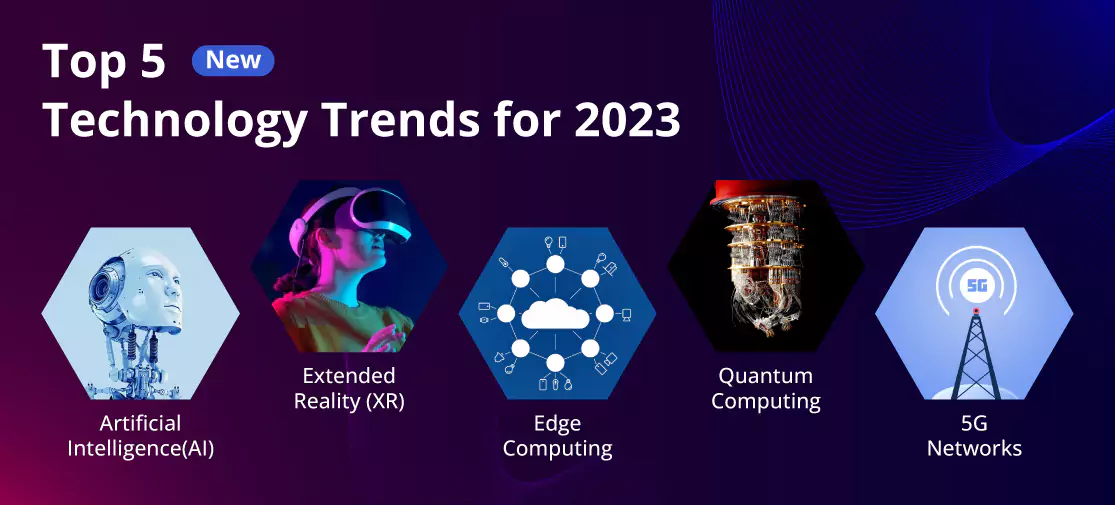Artificial Intelligence (AI)
- Introduction: AI is a rapidly advancing technology that involves the creation of intelligent machines that can perform tasks that typically require human intelligence, such as learning, problem-solving, and decision-making.
- Applications of AI: AI has numerous applications across various industries, including healthcare, finance, manufacturing, and retail. AI can be used in healthcare for medical diagnosis, drug discovery, and personalized medicine. In finance, AI can help with fraud detection and risk management. In manufacturing, AI can improve supply chain management and quality control. In retail, AI can help with inventory management and customer personalization.
- Types of AI: AI can be categorized into two main types: narrow or weak AI and general or strong AI. Narrow AI is designed to perform specific tasks, while general AI is designed to perform any intellectual task that a human can.
- Machine learning (ML): ML is a subset of AI that involves training machines to learn from data. ML algorithms can be used for tasks such as predictive analytics, natural language processing (NLP), and image recognition.
- Natural language processing (NLP): NLP is an area of AI that focuses on understanding and interpreting human language. NLP-powered systems, such as virtual assistants and chatbots, are becoming more sophisticated and accurate, making them more useful for customers and organizations.
- Robotics: Robotics is an area of AI that involves the design and development of robots that can perform tasks in the physical world. Robotics has numerous applications, including manufacturing, healthcare, and space exploration.
- Ethics and AI: As AI becomes more pervasive, ethical considerations become more important. AI ethics involves issues such as bias, transparency, and accountability. Organizations will need to develop policies and guidelines to ensure that AI is used in a responsible and ethical manner.
Extended Reality (XR)
- Introduction: Extended Reality (XR) is a technology that combines virtual reality (VR), augmented reality (AR), and mixed reality (MR) to create immersive experiences for users. XR is expected to have a significant impact on various industries, including gaming, entertainment, education, and healthcare.
- Virtual reality (VR): VR is a type of XR that involves creating a simulated environment that users can interact with using a headset or other immersive device. VR has numerous applications, including gaming, training, and therapy.
- Augmented reality (AR): AR is a type of XR that involves overlaying digital information in the real world. AR can be used for navigation, education, and marketing tasks.
- Mixed reality (MR): MR is a type of XR that combines elements of both VR and AR. MR allows users to interact with digital objects in the real world and vice versa.
- Applications of XR: XR has numerous applications across various industries. In gaming, XR can provide more immersive experiences for players. In entertainment, XR can be used for virtual concerts and events. In education, XR can be used for simulations and training. In healthcare, XR can be used for therapy and pain management.
- XR devices: XR devices include headsets, glasses, and other immersive devices. Popular XR devices include the Oculus Quest, HTC Vive, and Microsoft HoloLens.
- XR development: Developing XR experiences involves creating 3D models, programming interactions, and optimizing performance. XR developers use tools such as Unity and Unreal Engine to create immersive experiences.
Edge Computing
- Introduction: Edge computing is a distributed computing paradigm that brings computation and data storage closer to the location where it is needed. This is in contrast to traditional cloud computing, which involves centralized data centers located far away from the users.
- Benefits of edge computing: Edge computing offers several benefits, including reduced latency, improved data privacy, and increased bandwidth. By processing data closer to the source, edge computing can reduce the time it takes for data to travel to the cloud and back, resulting in faster response times. Edge computing can also improve data privacy by keeping sensitive data closer to the source and reducing the risk of data breaches. Finally, edge computing can increase bandwidth by reducing the amount of data that needs to be sent to the cloud.
- Applications of edge computing: Edge computing has numerous applications across various industries, including manufacturing, healthcare, and transportation. In manufacturing, edge computing can be used for predictive maintenance and quality control. In healthcare, edge computing can be used for remote patient monitoring and medical imaging. In transportation, edge computing can be used for autonomous vehicles and traffic management.
- Edge computing architecture: Edge computing architecture involves a hierarchy of nodes, ranging from edge devices to cloud data centers. Edge devices, such as sensors and gateways, collect and process data locally. Edge servers, located closer to the edge devices, provide additional processing power and storage. Finally, cloud data centres provide additional compute and storage resources for complex tasks.
- Edge computing technologies: Edge computing technologies include hardware and software components such as edge servers, gateways, and edge computing platforms. Popular edge computing platforms include Amazon Web Services (AWS) Greengrass, Microsoft Azure IoT Edge, and Google Cloud IoT Edge.
- Edge computing standards: As edge computing becomes more widespread, standards are emerging to ensure interoperability and compatibility between different edge computing technologies. These include the Open Edge Computing Initiative (OECI) and the Industrial Internet Consortium (IIC).
Quantum computing
- Introduction: Quantum computing is a new computing paradigm that uses quantum mechanics to perform computations. Quantum computers use qubits, which are analogous to classical bits, but can exist in multiple states simultaneously. This allows quantum computers to perform certain calculations much faster than classical computers.
- Benefits of quantum computing: Quantum computing offers several benefits, including faster computation times, improved encryption, and increased simulation capabilities. By exploiting the properties of quantum mechanics, quantum computers can solve certain problems much faster than classical computers. Quantum computing can also improve encryption by making it more difficult to break cryptographic codes. Finally, quantum computing can improve simulation capabilities by allowing researchers to model complex systems more accurately.
- Applications of quantum computing: Quantum computing has numerous applications across various industries, including finance, pharmaceuticals, and logistics. In finance, quantum computing can be used for portfolio optimization and risk analysis. In pharmaceuticals, quantum computing can be used for drug discovery and protein folding. In logistics, quantum computing can be used for route optimization and supply chain management.
- Quantum computing architecture: Quantum computing architecture involves a hierarchy of qubits, ranging from individual qubits to quantum processors. Quantum processors, which can contain hundreds or thousands of qubits, are connected by a network of wires that allow them to communicate and perform calculations.
- Quantum computing technologies: Quantum computing technologies include hardware and software components such as quantum processors, quantum algorithms, and quantum simulators. Popular quantum computing platforms include IBM Quantum Experience, Microsoft Quantum, and Google Quantum AI.
- Quantum computing standards: As quantum computing becomes more widespread, standards are emerging to ensure interoperability and compatibility between different quantum computing technologies. These include the Quantum Open-Source Foundation (QOSF) and the Quantum Industry Consortium (QIC).
5G networks
- Introduction to 5G networks: 5G networks are the latest generation of mobile networks that offer faster data speeds, lower latency, and increased capacity compared to 4G networks. 5G networks are built on advanced technologies such as millimeter wave frequencies, Massive MIMO, and beamforming, which allow for faster data transfer and reduced lag.
- Benefits of 5G networks: 5G networks offer several benefits, including faster data transfer speeds, reduced latency, increased capacity, and improved network reliability. These benefits are critical for supporting emerging technologies such as Internet of Things (IoT), autonomous vehicles, and augmented reality (AR) applications.
- Applications of 5G networks: 5G networks have numerous applications across various industries, including healthcare, transportation, and entertainment. In healthcare, 5G networks can be used for remote patient monitoring and telemedicine. In transportation, 5G networks can be used for vehicle-to-vehicle communication and traffic management. In entertainment, 5G networks can be used for high-quality video streaming and immersive gaming experiences.
- 5G Network architecture: 5G network architecture involves a hierarchy of components, ranging from base stations to core networks. Base stations, which are the access points for 5G networks, are connected by a fiber-optic network that allows them to communicate and transfer data. Core networks, which are responsible for processing and routing data, are connected to the base stations via high-speed fiber-optic cables.
- 5G network technologies: 5G network technologies include hardware and software components such as base stations, antennas, and radios. Popular 5G network providers include Verizon, AT&T, and T-Mobile.
- 5G network standards: As 5G networks become more widespread, standards are emerging to ensure interoperability and compatibility between different 5G network technologies. These include the 3rd Generation Partnership Project (3GPP) and the International Telecommunication Union (ITU).
Conclusion
In conclusion, these technology trends are shaping the future of many industries and are transforming the way we live and work. AI is revolutionizing how businesses operate and is improving decision-making processes. Extended Reality (XR) is transforming the way we interact with the world and creating new opportunities for immersive experiences. Edge computing is providing faster and more efficient data processing, allowing for real-time decision-making and improved network performance. Quantum computing is enabling advanced computing capabilities that were previously impossible, and 5G networks are providing faster data speeds, reduced latency, and increased capacity to support emerging technologies such as IoT, autonomous vehicles, and AR applications.




